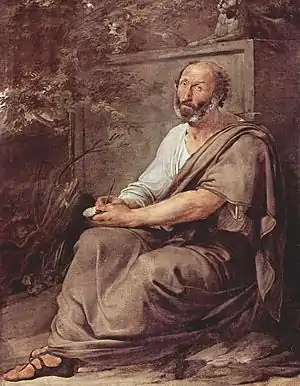On Youth, Old Age, Life and Death, and Respiration
On Youth, Old Age, Life and Death, and Respiration (Greek: Περὶ νεότητος καὶ γήρως, καὶ ζωῆς καὶ θανάτου, καὶ ἀναπνοῆς; Latin: De Juventute et Senectute, De Vita et Morte, De Respiratione) is one of the short treatises that make up Aristotle's Parva Naturalia.
 |
| Part of a series on the |
| Corpus Aristotelicum |
|---|
| Logic (Organon) |
| Natural philosophy (physics) |
|
| Metaphysics |
|
|
|
|
[*]: Generally agreed to be spurious [†]: Authenticity disputed |
Structure and contents
Place in the Parva Naturalia
In comparison to the first five treatises of the Parva Naturalia, this one and On Length and Shortness of Life, while still dealing with natural phenomena involving the body and the soul, are "definitely biological rather than psychological."[1] They are omitted from the Parva Naturalia commentary of Sophonias.
Title and divisions of the treatise
Modern editions divide the treatise into 27 chapters. The Bekker edition of Aristotle's works distinguished two works, De Senectute et Juventute (chapters 1-6), and De Respiratione (chapters 7-27, for this reason sometimes cited as De Respiratione, chapters 1-21). However, the manuscripts give no basis for this distinction, and the contents are not accurately described by these labels; youth and old age only come into focus as "part of the explanation of life as a whole" in chapter 24. The work may, instead, be considered as a single, unified treatise on life, death, and the functions necessary to life: nutrition and respiration.[2] The title On Youth, Old Age, Life and Death, and Respiration, given in the Medieval manuscripts, derives from the treatise's opening words: "We must now treat of youth and old age and life and death. We must probably also at the same time state the causes of respiration as well, since in some cases living and the reverse depend on this." This statement explains how respiration is part of the more general subject of life and death. While De Vita et Morte might, then, seem to be a more satisfactory title for the work (and Ptolemy Chennus refers to the whole in this way), youth and old age are important aspects of the subject, because Aristotle's conception "is not of a constant, unvarying life" but of a life-cycle of natural development and decay.[2]
The heart as the primary organ of soul
Aristotle begins by raising the question of the seat of life in the body ("while it is clear that [the soul's] essential reality cannot be corporeal, yet manifestly it must exist in some bodily part which must be one of those possessing control over the members") and arrives at the answer that the heart is the primary organ of soul, and the central organ of nutrition and sensation (with which the organs of the five senses communicate).[3] The motivation for this "disappointing feature of Aristotle's physiology" is a matter of conjecture; the importance of the brain had been suggested before Aristotle by Alcmaeon of Croton (on the basis of "the fact...that the end-organs of smell and sight are connected with the brain," with which Aristotle was familiar[4]), and this had been accepted in turn by Diogenes of Apollonia, Democritus, and Plato.[3]
Heart, lungs, and respiration
Aristotle's account of the heart provides one of the clearest indications that he was familiar with the medical theories of some parts of the Hippocratic Corpus. Among other debts, "his comparison of the heart-lung system to a double bellows (ch. 26, 480a20-23) is clearly borrowed from the earlier treatise" On Regimen (De Victu).[3] That is, the heart ("hot substance" in animals) is inside the lungs ("the primary organ of cooling," a function also served by gills); the heart expands under the influence of heat, forcing the lungs to expand under the same influence, causing inhalation, and this introduction of cold air from outside in turn causes contraction and exhalation. In this continuous process, "life and respiration are inseparable."[5]
The life-cycle
Chapter 24 of the treatise gives several definitions that summarize Aristotle's theory.[5]
| generation (birth) | the initial participation in the nutritive soul, mediated by warm substance (i.e., in animals, the heart, in which the nutritive soul is incorporated) |
| life | the maintenance of this participation |
| youth | the period of the growth of the primary organ of refrigeration (the lungs) |
| the prime of life | the intervening time between the growth and decay of the primary organ of refrigeration |
| old age | the decay of the primary organ of refrigeration |
| violent death or dissolution | the extinction or exhaustion of the vital heat |
| natural death | the exhaustion of the heat owing to lapse of time, and occurring at the end of life |
| death, in old age | the exhaustion due to inability on the part of the organ, owing to old age, to produce refrigeration |
Commentaries
- Michael of Ephesus, CAG XXII.1 (Greek text)
- W. D. Ross, Aristotle: Parva Naturalia, Oxford, 1955
Notes
- Ross, p. 52
- King, pp. 38–40
- Ross, pp. 55f.
- Sense and Sensibilia, 438b25–30, 444a9
- Ross, pp. 60f.
References
- R.A.H. King, Aristotle on Life and Death, London: Duckworth, 2001
External links
 Works related to On Youth and Old Age at Wikisource
Works related to On Youth and Old Age at Wikisource Works related to On Life and Death at Wikisource
Works related to On Life and Death at Wikisource Works related to On Breathing at Wikisource
Works related to On Breathing at Wikisource- Ancient Greek text (with translation and notes in Modern Greek)
- English translation by G.R.T. Ross: University of Adelaide eBooks (HTML), MIT Classics Archive (HTML), Archive.org (scan of published version, with Bekker numbers and notes, beginning on p. 406 of the PDF file)
 Parva Naturalia public domain audiobook at LibriVox
Parva Naturalia public domain audiobook at LibriVox